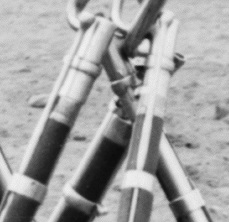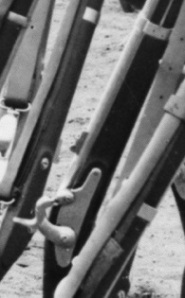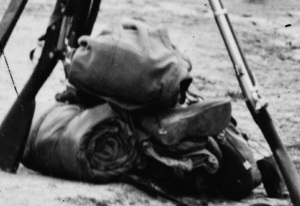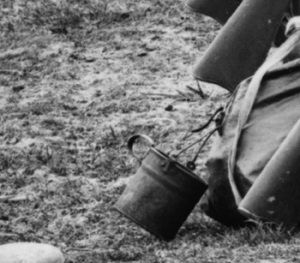Stacked Arms: a Photographic Study of Federal Late-War Arms and Accoutrements
by Phil Spaugy
As a long-time student of the arms and accoutrements of the Federal soldier of the American Civil War, I have always been drawn to the image below:
Taken at Petersburg, Virginia in late 1864 or early 1865, the image shows a row of stacked rifle muskets along with various items of equipage carried by the common Federal infantryman in the later stages of the American Civil War. Thanks to modern technology, this image is available in several downloadable formats from the Library of Congress website (http://www.loc.gov/pictures/collection/cwp/). Once downloaded, one can enlarge the image and get a great view of the arms and other equipage carried by “Billy Yank” during the last eastern campaign of the war. (If the image looks familiar, it is depicted on one of the large wall murals on display at the Gettysburg National Battlefield Park Visitor Center.
The following are some enlargements of items in this image that I have found interesting. I encourage those interested in further studying this and other images to access the LOC website and see what “hidden treasures” you might find.
The Arms
The first thing one notices when the image is enlarged is that the arms are obviously well-kept and burnished bright, with a mix of Model 1861, 1863, and 1864 (aka Model 1863 Type II) pattern rifle muskets in the stacks of arms.
You can tell the Model 1861’s from the Model 1863’s by the hammer shape or style, flat barrel bands and band retaining springs of the Model 1861, versus the redesigned hammer, oval, screw-tightened bands of the Model 1863’s which lack band retaining springs. The Model 1861’s also had a distinctive swell to the ramrod to secure the ramrod in the ramrod channel, whereas the M1863/64’s used a ramrod retaining spoon in the stock, which enabled the ramrod to have a straight shaft.
 Three M1861 rifle muskets with swelled ramrods and flat barrel bands held in place by a retaining spring. Note the one M1863 rifle musket with the oval barrel bands held in place by a screw in the bottom of the band.
Three M1861 rifle muskets with swelled ramrods and flat barrel bands held in place by a retaining spring. Note the one M1863 rifle musket with the oval barrel bands held in place by a screw in the bottom of the band. Note the distinctive “C” shape of the M1861 hammer, a holdover from the M1855 series of arms in which the hammer had to clear the high hump of the Maynard tape primer lock-plate unique to that series of arms.
Note the distinctive “C” shape of the M1861 hammer, a holdover from the M1855 series of arms in which the hammer had to clear the high hump of the Maynard tape primer lock-plate unique to that series of arms. The third rifle musket from the left appears to be a Model 1864 (aka M1863 Type II), which had the retaining band springs added when it was discovered that the screw barrel bands showed a tendency to loosen during firing.
The third rifle musket from the left appears to be a Model 1864 (aka M1863 Type II), which had the retaining band springs added when it was discovered that the screw barrel bands showed a tendency to loosen during firing. Interesting closeup of a M1864 hammer resting on what appears to be an Enfield-style snap cap or nipple protector. When this image is enlarged, you can see that the arm is a M1864 with the barrel band retaining springs.
Interesting closeup of a M1864 hammer resting on what appears to be an Enfield-style snap cap or nipple protector. When this image is enlarged, you can see that the arm is a M1864 with the barrel band retaining springs.The Accoutrements
What I find interesting in the images below are the two methods of carrying the cartridge box: suspended on the belt or by the shoulder strap. Also note that the knapsacks are of the common double-bag pattern. There is what appears to be an over-the-shoulder sling suspension type of blanket roll in the first image below.
 In the lower left of this closeup there appears to be a blanket roll that was carried by an over-the-shoulder leather sling.
In the lower left of this closeup there appears to be a blanket roll that was carried by an over-the-shoulder leather sling. Model 1864 .58 caliber cartridge box with embossed “US” suspended on a M1856 enlisted man’s belt with the brass keeper.
Model 1864 .58 caliber cartridge box with embossed “US” suspended on a M1856 enlisted man’s belt with the brass keeper. Note the holes punched in the cartridge box strap for the missing eagle breastplate.
Note the holes punched in the cartridge box strap for the missing eagle breastplate. A tin container, commonly referred to as a mucket, appears to be attached to a buckle on a double-bag knapsack. “Billy Yank” oft-times added the wire bail to a tin cup or other container so that it could be suspended over a fire.
A tin container, commonly referred to as a mucket, appears to be attached to a buckle on a double-bag knapsack. “Billy Yank” oft-times added the wire bail to a tin cup or other container so that it could be suspended over a fire. M1858 “Improved” US issue canteen, which was strengthened by stamping concentric rings into the sides. This gave the canteen its nickname, the “Bullseye” canteen.
M1858 “Improved” US issue canteen, which was strengthened by stamping concentric rings into the sides. This gave the canteen its nickname, the “Bullseye” canteen. A full haversack with a tin cup secured by the haversack fastener strap.
A full haversack with a tin cup secured by the haversack fastener strap.And lastly, probably one of the the most important pieces of the soldiers equipment: a coffee pot, and a rather large one at that.
In closing, this image is a fine example of just how well the Federal soldier of the late war was equipped, which of course did not bode well for for the Confederacy in the spring of 1865.
Sources:
American Military Equipage, 1851-1872; Volume I; Frederick P. Todd; Company of Military Historians; 1974
American Military Shoulder Arms; Volume III; George D. Moller; University of New Mexico Press; 2011
American Military Belts and Related Equipments; R.Stephen Dorsey; Pioneer Press; 1984



Guessing the stacks to the left of the image are the NCO’s row?.
LikeLike
I would say you are correct !
LikeLike
Phil, It is kind neat the way the bail of the mucket is twisted into a central hook so that it may hung over the fire.
LikeLike
Good eye Bobby. I overlooked that great detail!
LikeLike
This is my FAVORITE picture! There are also Colt pattern muskets in the mix. The thing I find most interesting is the method in which the slings are “slung” on the muskets…much different than in other pictures and what has been shown as the “correct” way to attach them.
Thanks for sharing!
LikeLike